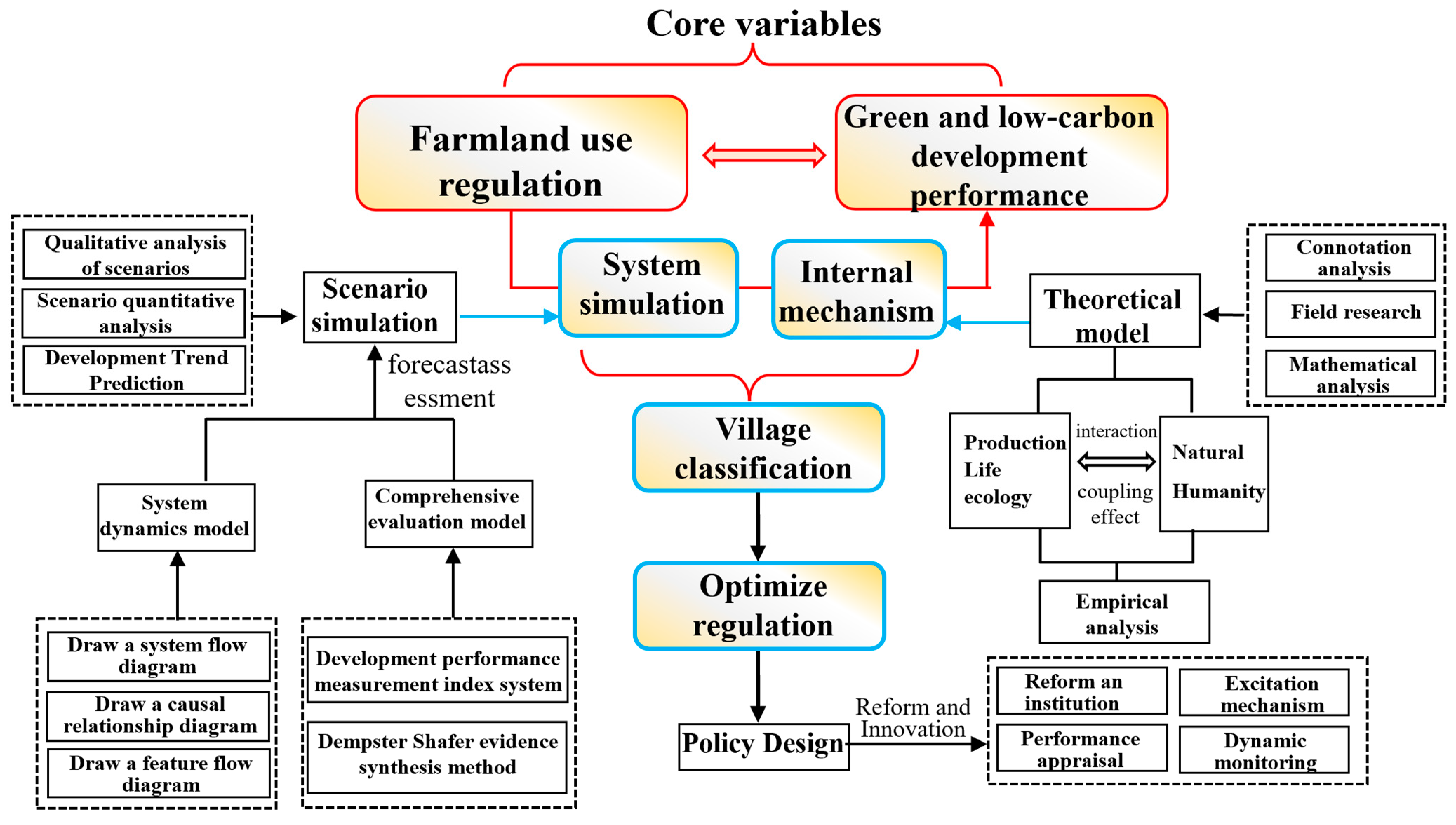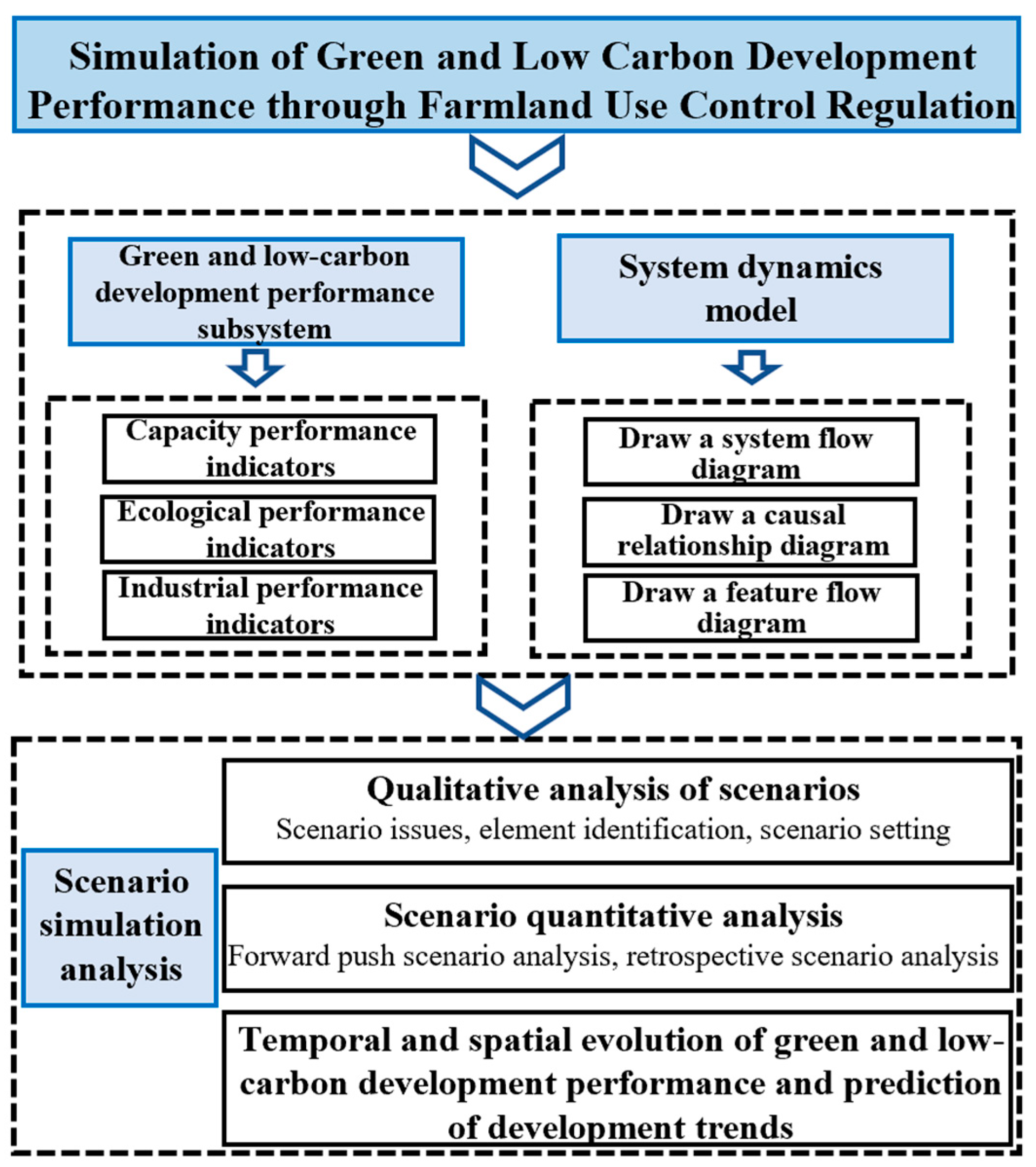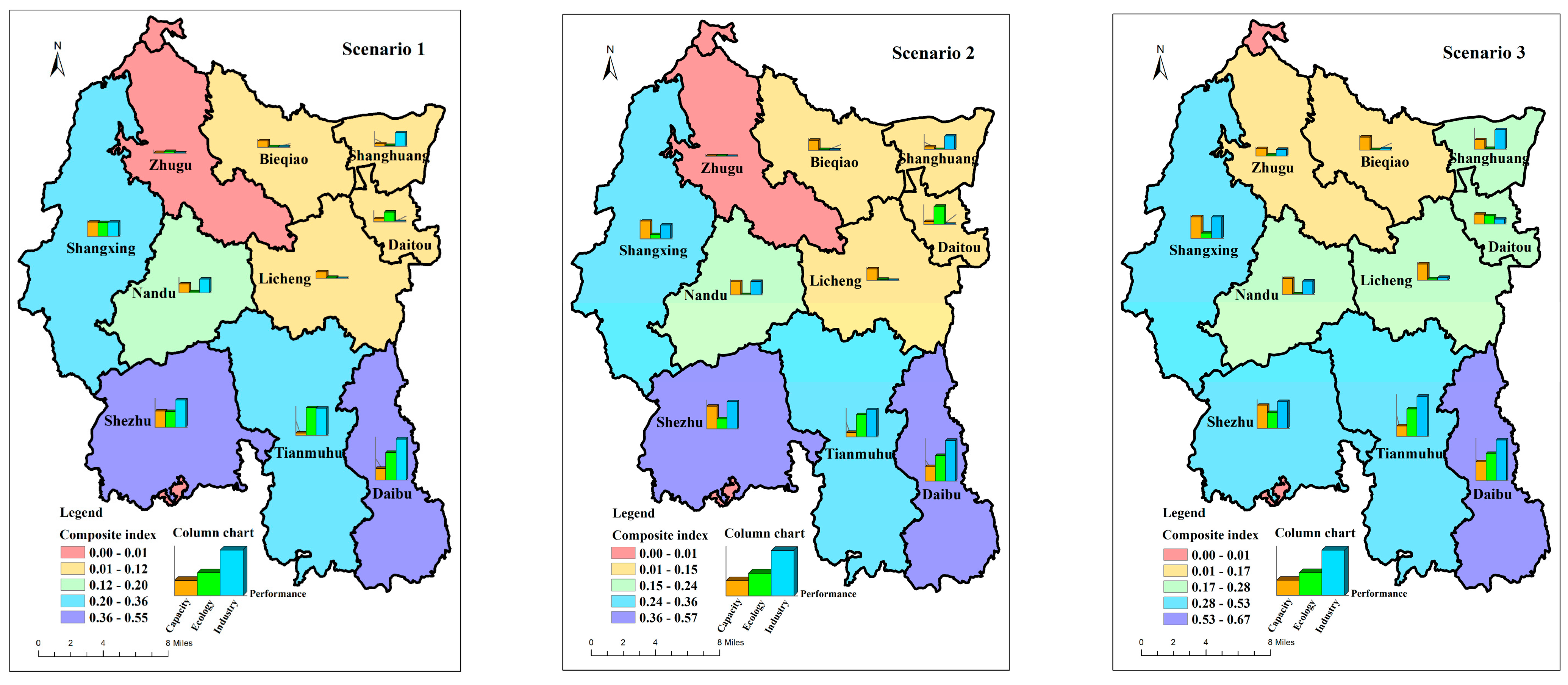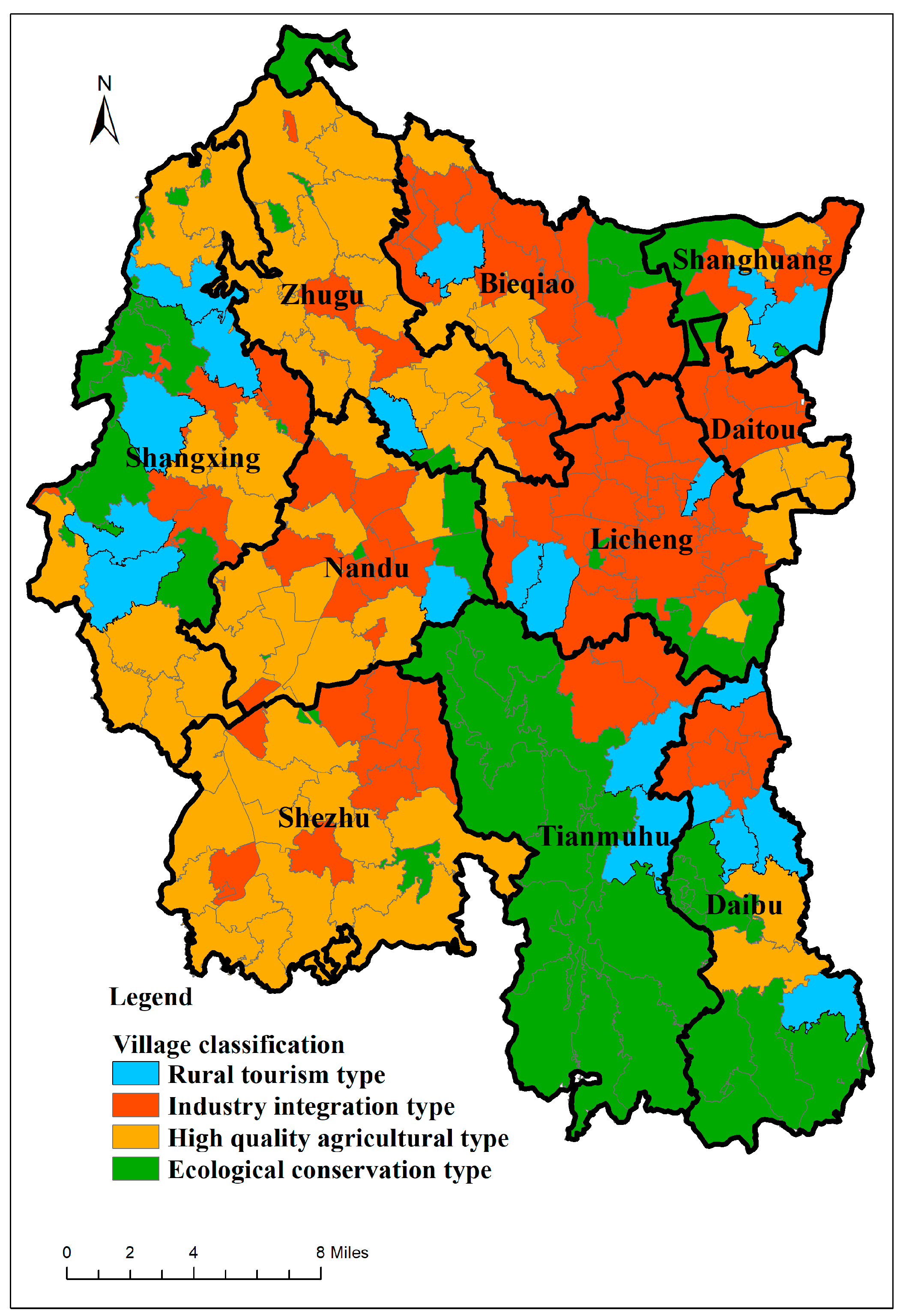Green and Low Carbon Development Performance in Farmland Use Regulation: A Case Study of Liyang City, China
Abstract
1. Introduction
2. Literature Review
3. Methods
3.1. Research Object
3.2. Research Approach
3.3. Research Methods
3.3.1. Dempster–Shafer Evidence Synthesis Method
3.3.2. Simulation and Modeling Schemes
4. Results
4.1. Measurement and Simulation of Green and Low-Carbon Development Performance under Farmland Use Regulation
4.1.1. Comprehensive Measurement Results of Green and Low-Carbon Development Performance under Farmland Use Regulation
4.1.2. Simulation and Modeling of Green and Low-Carbon Development Performance under Farmland Use Regulation
4.2. Village Classification Based on Farmland Use Regulation
5. Discussion
6. Conclusions and Recommendations
- (1)
- According to the comprehensive assessment of green and low-carbon development performance of farmland, Liyang City’s overall performance index also exhibits a pattern of higher values in the south and lower values in the north. Among the towns, Tianmuhu, Daibu, and Shezhu have higher average indices of 0.31, 0.30, and 0.28, respectively, which are significantly higher than those of other towns.
- (2)
- The simulation model for controlling the green and low-carbon development performance of farmland use shows that in Scenario 1, where new construction land occupies farmland, the comprehensive index is only 0.23, significantly lower than in the other two scenarios.
- (3)
- Based on calculations and field research, Liyang City’s villages are categorized into four types. Among these, Industry Integration Villages are the most numerous, with a total of 94. Based on this classification, differentiated farmland use regulation policies are designed for each village type.
- (1)
- Reform the Farmland Use Regulation System: To effectively enhance the green and low-carbon development performance of farmland use regulation, systemic reforms are needed. This includes developing a policy system that emphasizes a “trinity” approach of quantity, quality, and ecology, improving the permanent basic farmland designation system, refining dynamic monitoring technologies and systems to rigorously address illegal land occupation, and strengthening safeguarding measures and regulatory assessment systems.
- (2)
- Establish an Incentive Mechanism for Farmland Use Regulation: To encourage farmers and local governments to actively protect farmland and deter land users from occupying it, measures should be designed to increase the comparative benefits of farmland, raise the costs of land occupation, and reform the performance evaluation system for local government officials.
- (3)
- Develop a Green and Low-Carbon Development Performance Evaluation System: There is currently no established evaluation system for green and low-carbon development performance related to farmland protection. It is recommended that a comprehensive decision-making evaluation index system for farmland use regulation be developed under the green and low-carbon development framework. This system should include indicators related to capacity (agricultural development foundation, agricultural infrastructure, food quality and safety, etc.), ecology (pollution levels, carbon sequestration function, climate conditions, etc.), and industry (rural tourism, industrial integration, etc.).
- (4)
- Establish a Dynamic Monitoring System for Farmland Protection: The system should initially prioritize ground-based manual monitoring while also extensively employing modern remote sensing and other advanced technologies to track changes in farmland, especially near urban areas. This approach will provide scientific evidence for informed land protection decisions and enforcement.
Author Contributions
Funding
Data Availability Statement
Conflicts of Interest
References
- Di Foggia, G.; Beccarello, M. European roadmaps to achieving 2030 renewable energy targets. Util. Policy 2024, 88, 101729. [Google Scholar]
- Jackson, H.B.; Kroetz, K.; Sanchirico, J.N.; Thompson, A.; Armsworth, P.R. Protected area, easement, and rental contract data reveal five communities of land protection in the United States. Ecol. Appl. 2021, 31, e02322. [Google Scholar] [CrossRef] [PubMed]
- Qian, Y.; Sun, L.; Chen, D.; Liao, J.; Tang, L.; Sun, Q. The response of the migration of non-point source pollution to land use change in a typical small watershed in a semi-urbanized area. Sci. Total Environ. 2021, 785, 147387. [Google Scholar] [CrossRef]
- Su, Y.; Li, Y.; Chen, X.; Wang, Y.; Zang, L. Farmland titling, farmland adjustment and rural collective action: Application of institutional analysis and development framework using evidence from China’s irrigation commons. J. Rural. Stud. 2023, 102, 103089. [Google Scholar] [CrossRef]
- Cao, R.; Zhang, A.; Wen, L. Trans-regional compensation mechanism under imbalanced land development: From the local government economic welfare perspective. Habitat Int. 2018, 77, 56–63. [Google Scholar] [CrossRef]
- Yang, X.; Wan, Z.; Xiao, J.; Li, F.; Zhang, F.; Zhang, Z. Evaluation of niche, diversity, and risks of microplastics in farmland soils of different rocky desertification areas. J. Hazard. Mater. 2024, 466, 133603. [Google Scholar] [CrossRef]
- Li, H.; Wu, Y.; Huang, X.; Sloan, M.; Skitmore, M. Spatial-temporal evolution and classification of marginalization of cultivated land in the process of urbanization. Habitat Int. 2017, 61, 1–8. [Google Scholar] [CrossRef]
- Bucała-Hrabia, A. Reflections on land use and land cover change under different socio-economic regimes in the Polish Western Carpathians. Reg. Environ. Change 2024, 24, 28. [Google Scholar] [CrossRef]
- Subi, X.; Eziz, M.; Zhong, Q.; Li, X. Estimating the chromium concentration of farmland soils in an arid zone from hyperspectral reflectance by using partial least squares regression methods. Ecol. Indic. 2024, 161, 111987. [Google Scholar] [CrossRef]
- Yasar, K.S.; Korkanc, M.; Amiri, A.F. Effects of land use/cover change on heavy metal distribution of soils in wetlands and ecological risk assessment. Sci. Total Environ. 2024, 923, 171603. [Google Scholar] [CrossRef]
- Su, B.; Liu, M. Coupling management ecosystem service supply-supply trade-offs and supply–demand trade-offs: Framework and practice. Ecol. Indic. 2024, 166, 112258. [Google Scholar] [CrossRef]
- Wang, J.; Wang, J.; Zhang, M.; Zhang, J. Optimization of land use structure based on an improved multi-objective genetic algorithm: A case study in a large-scale opencast coal mine area, China. Environ. Dev. Sustain. 2024. [Google Scholar] [CrossRef]
- Yang, B.; Sheng, S.; Shangguan, Z.; Ke, X. Interregional compensation for farmland protection: From the perspective of farmland allocation optimization. J. Geogr. Sci. 2024, 34, 1437–1454. [Google Scholar] [CrossRef]
- Wang, H.; Zhou, W.; Ma, R.; Wang, J.; Zhang, H. Is marginalised cultivated land on the Tibetan Plateau suitable for production or ecology? An example from the northeastern Tibetan Plateau. Land Degrad. Dev. 2024, 35, 1818–1836. [Google Scholar] [CrossRef]
- Agarwal, B.; Mahesh, M. Does the Landowner’s Gender Affect Self-Cultivation and Farm Productivity? An Analysis for India. J. Dev. Stud. 2023, 59, 758–777. [Google Scholar] [CrossRef]
- Kwak, J.; Kim, J.; Lee, H.; Kim, S.; Kim, S.; Kang, M.S. Evaluation of future flood probability in agricultural reservoir watersheds using an integrated flood simulation system. J. Hydrol. 2024, 628, 130463. [Google Scholar] [CrossRef]
- Sun, W.; Sheng, W.; Zhou, R.; Zhu, Y.; Chen, A.; Zhao, S.; Zhang, Q. Deep edge enhancement-based semantic segmentation network for farmland segmentation with satellite imagery. Comput. Electron. Agric. 2022, 202, 107273. [Google Scholar] [CrossRef]
- Zheng, J.; Huang, Q.; Chen, Y.; Huang, B.; He, Y. Peri-urban farmland zoning based on morphology and machine learning: A case study of Changzhou City, China. Environ. Earth Sci. 2024, 83, 137. [Google Scholar] [CrossRef]
- Feitelson, E.; Felsenstein, D.; Razin, E.; Stern, E. Assessing land use plan implementation: Bridging the performance-conformance divide. Land Use Policy 2017, 61, 251–264. [Google Scholar] [CrossRef]
- Qie, L.; Pu, L.; Tang, P.; Liu, R.; Huang, S.; Xu, F.; Zhong, T. Gains and losses of farmland associated with farmland protection policy and urbanization in China: An integrated perspective based on goal orientation. Land Use Policy 2023, 129, 106643. [Google Scholar] [CrossRef]
- Boyabatli, O.; Nasiry, J.; Zhou, Y.H. Crop Planning in Sustainable Agriculture: Dynamic Farmland Allocation in the Presence of Crop Rotation Benefits. Manag. Sci. 2019, 65, 2060–2076. [Google Scholar] [CrossRef]
- Guo, Y.; Cui, M.; Xu, Z. Performance Environment, Contract Binding, and the Contract Structure of the Farmland Transfer Market. Land 2023, 12, 1582. [Google Scholar] [CrossRef]
- Borrelli, P.; Panagos, P.; Alewell, C.; Ballabio, C.; de Oliveira Fagundes, H.; Haregeweyn, N.; Lugato, E.; Maerker, M.; Poesen, J.; Vanmaercke, M.; et al. Policy implications of multiple concurrent soil erosion processes in European farmland. Nat. Sustain. 2023, 6, 103–112. [Google Scholar] [CrossRef]
- Liu, Y.; Liu, L.; Zhu, A.; Lao, C.; Hu, G.; Hu, Y. Scenario farmland protection zoning based on production potential: A case study in China. Land Use Policy 2020, 95, 104581. [Google Scholar] [CrossRef]
- Buehren, N.; Goldstein, M.; Molina, E.; Vaillant, J. The impact of strengthening agricultural extension services on women farmers: Evidence from Ethiopia. Agric. Econ. 2019, 50, 407–419. [Google Scholar] [CrossRef]
- Liu, Y.; Zhang, Z.; Zhou, Y. Efficiency of construction land allocation in China: An econometric analysis of panel data. Land Use Policy 2018, 74, 261–272. [Google Scholar] [CrossRef]
- Xiang, J.; Han, P.; Chen, W. Coordinated development efficiency between cultivated land spatial morphology and agricultural economy in underdeveloped areas in China: Evidence from western Hubei province. J. Geogr. Sci. 2023, 33, 801–822. [Google Scholar] [CrossRef]
- Davies, R.W.; Morton, O.; Lawson, D.; Mallord, J.W.; Nelson, L.; Boafo, K.; Lamb, I.; Edwards, D.P. Protecting habitats in low-intensity tropical farmland using carbon-based payments for ecosystem services. Environ. Res. Lett. 2021, 16, 114022. [Google Scholar] [CrossRef]
- Wan, X.; Lei, M.; Chen, T.; Tan, Y.; Yang, J. Safe utilization of heavy-metal-contaminated farmland by mulberry tree cultivation and silk production. Sci. Total Environ. 2017, 599–600, 1867–1873. [Google Scholar] [CrossRef]
- You, H.; Li, J.; Xu, F. Off-farm employment and nonpoint source pollution from chemical fertilizers in China: Mediating role of farmland transfer. Environ. Dev. Sustain. 2024. [Google Scholar] [CrossRef]
- Alarcón-Segura, V.; Roilo, S.; Paulus, A.; Beckmann, M.; Klein, N.; Cord, A.F. Farm structure and environmental context drive farmers’ decisions on the spatial distribution of ecological focus areas in Germany. Landsc. Ecol. 2023, 38, 2293–2305. [Google Scholar] [CrossRef]
- Valliant, J.C.D.; Ruhf, K.Z.; Gibson, K.D.; Brooks, J.R.; Farmer, J.R. Fostering farm transfers from farm owners to unrelated, new farmers: A qualitative assessment of farm link services. Land Use Policy 2019, 86, 438–447. [Google Scholar] [CrossRef]
- Jean Vasile, A.; Raluca Andreea, I.; Popescu, G.H.; Elvira, N.; Marian, Z. Implications of agricultural bioenergy crop production and prices in changing the land use paradigm—The case of Romania. Land Use Policy 2016, 50, 399–407. [Google Scholar] [CrossRef]
- Twumasi, M.A.; Jiang, Y.; Ntiamoah, E.B.; Akaba, S.; Darfor, K.N.; Boateng, L.K. Access to credit and farmland abandonment nexus: The case of rural Ghana. Nat. Resour. Forum 2022, 46, 3–20. [Google Scholar] [CrossRef]
- Albrecht, M.; Kleijn, D.; Williams, N.M.; Tschumi, M.; Blaauw, B.R.; Bommarco, R.; Campbell, A.J.; Dainese, M.; Drummond, F.A.; Entling, M.H.; et al. The effectiveness of flower strips and hedgerows on pest control, pollination services and crop yield: A quantitative synthesis. Ecol. Lett. 2020, 23, 1488–1498. [Google Scholar] [CrossRef]
- Hazeu, G.; Milenov, P.; Pedroli, B.; Samoungi, V.; Van Eupen, M.; Vassilev, V. High Nature Value farmland identification from satellite imagery, a comparison of two methodological approaches. Int. J. Appl. Earth Obs. Geoinf. 2014, 30, 98–112. [Google Scholar] [CrossRef]
- Olsen, V.M.; Fensholt, R.; Olofsson, P.; Bonifacio, R.; Van Butsic Druce, D.; Ray, D.; Prishchepov, A.V. The impact of conflict-driven cropland abandonment on food insecurity in South Sudan revealed using satellite remote sensing. Nat. Food 2022, 2, 990–996. [Google Scholar] [CrossRef]
- Marja, R.; Kleijn, D.; Tscharntke, T.; Klein, A.M.; Frank, T.; Batary, P. Effectiveness of agri-environmental management on pollinators is moderated more by ecological contrast than by landscape structure or land-use intensity. Ecol. Lett. 2019, 22, 1493–1500. [Google Scholar] [CrossRef]
- Török, E.; Zieger, S.; Rosenthal, J.; Földesi, R.; Gallé, R.; Tscharntke, T.; Batáry, P. Organic farming supports lower pest infestation, but fewer natural enemies than flower strips. J. Appl. Ecol. 2021, 58, 2277–2286. [Google Scholar] [CrossRef]
- Albers, A.; Avadí, A.; Benoist, A.; Collet, P.; Hélias, A. Modelling dynamic soil organic carbon flows of annual and perennial energy crops to inform energy-transport policy scenarios in France. Sci. Total Environ. 2020, 718, 135278. [Google Scholar] [CrossRef]
- Lambotte, M.; De Cara, S.; Brocas, C.; Bellassen, V. Organic farming offers promising mitigation potential in dairy systems without compromising economic performances. J. Environ. Manag. 2023, 334, 117405. [Google Scholar] [CrossRef] [PubMed]
- Devi, R.R.; Banerjee, S.; Chattopadhyay, S. Dempster-Shafer and LSTM based analysis and forecasting of total ozone data. Remote Sens. Lett. 2023, 14, 1036–1045. [Google Scholar] [CrossRef]






| Township | Scenario 1: Conversion of Farmland for New Construction | Scenario 2: Conversion of Ecological Land for New Construction | Scenario 3: Conversion of Other Land Uses for New Construction | |||||||||
|---|---|---|---|---|---|---|---|---|---|---|---|---|
| PP | EP | IP | R | PP | EP | IP | R | PP | EP | IP | R | |
| Zhuzhe | 0.01 | 0.04 | 0.00 | 0.01 | 0.01 | 0.01 | 0.00 | 0.01 | 0.18 | 0.02 | 0.16 | 0.14 |
| Tianmuhu | 0.06 | 0.67 | 0.66 | 0.36 | 0.11 | 0.54 | 0.66 | 0.36 | 0.26 | 0.68 | 0.99 | 0.53 |
| Shezhu | 0.39 | 0.38 | 0.66 | 0.46 | 0.55 | 0.24 | 0.66 | 0.50 | 0.57 | 0.39 | 0.66 | 0.53 |
| Shangxing | 0.34 | 0.33 | 0.34 | 0.34 | 0.43 | 0.10 | 0.34 | 0.33 | 0.53 | 0.13 | 0.53 | 0.44 |
| Shanghuang | 0.06 | 0.02 | 0.33 | 0.12 | 0.06 | 0.00 | 0.33 | 0.11 | 0.23 | 0.02 | 0.48 | 0.24 |
| Nandu | 0.21 | 0.02 | 0.33 | 0.20 | 0.32 | 0.00 | 0.33 | 0.24 | 0.39 | 0.01 | 0.33 | 0.28 |
| Licheng | 0.16 | 0.02 | 0.00 | 0.09 | 0.28 | 0.03 | 0.00 | 0.15 | 0.40 | 0.03 | 0.07 | 0.22 |
| Daibu | 0.28 | 0.67 | 0.99 | 0.55 | 0.35 | 0.62 | 0.99 | 0.57 | 0.46 | 0.67 | 1.00 | 0.67 |
| Daitou | 0.07 | 0.23 | 0.00 | 0.09 | 0.07 | 0.44 | 0.00 | 0.14 | 0.24 | 0.20 | 0.12 | 0.21 |
| Bieqiao | 0.15 | 0.01 | 0.01 | 0.08 | 0.25 | 0.02 | 0.01 | 0.13 | 0.32 | 0.01 | 0.03 | 0.17 |
| Average | 0.17 | 0.24 | 0.33 | 0.23 | 0.24 | 0.20 | 0.33 | 0.25 | 0.36 | 0.21 | 0.44 | 0.34 |
| Classification Criteria | Classification Results | ||||
|---|---|---|---|---|---|
| PP | EP | IP | R | Scenario Simulation Requirements | |
| / | / | >0.1 | >0.1 | According to Scenario 3, the available construction land area exceeds 60 hectares. | Industry Integration Type |
| >0.1 | / | >0 | >0.1 | According to Scenario 1, the available construction land area exceeds 15 hectares. | High-quality agricultural type |
| / | >0 | >0 and with high-quality tourism resources | >0.1 | According to Scenario 3, the available construction land area is greater than 15 hectares. | Rural Tourism Type |
| / | >0 | / | <0.1 | According to Scenario 2, the available construction land area is greater than 0 hectares. | Ecological Conservation Type |
Disclaimer/Publisher’s Note: The statements, opinions and data contained in all publications are solely those of the individual author(s) and contributor(s) and not of MDPI and/or the editor(s). MDPI and/or the editor(s) disclaim responsibility for any injury to people or property resulting from any ideas, methods, instructions or products referred to in the content. |
© 2024 by the authors. Licensee MDPI, Basel, Switzerland. This article is an open access article distributed under the terms and conditions of the Creative Commons Attribution (CC BY) license (https://creativecommons.org/licenses/by/4.0/).
Share and Cite
Lin, Y.; Wang, X.; Li, G.; Shen, W. Green and Low Carbon Development Performance in Farmland Use Regulation: A Case Study of Liyang City, China. Land 2024, 13, 1365. https://doi.org/10.3390/land13091365
Lin Y, Wang X, Li G, Shen W. Green and Low Carbon Development Performance in Farmland Use Regulation: A Case Study of Liyang City, China. Land. 2024; 13(9):1365. https://doi.org/10.3390/land13091365
Chicago/Turabian StyleLin, Yaoben, Xuewen Wang, Guangyu Li, and Wei Shen. 2024. "Green and Low Carbon Development Performance in Farmland Use Regulation: A Case Study of Liyang City, China" Land 13, no. 9: 1365. https://doi.org/10.3390/land13091365
APA StyleLin, Y., Wang, X., Li, G., & Shen, W. (2024). Green and Low Carbon Development Performance in Farmland Use Regulation: A Case Study of Liyang City, China. Land, 13(9), 1365. https://doi.org/10.3390/land13091365






